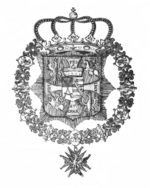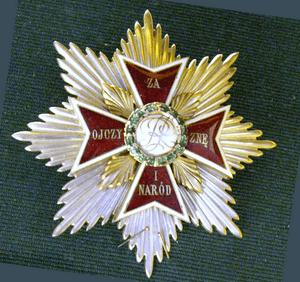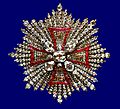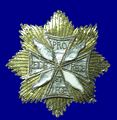Order of the White Eagle (Poland) facts for kids
Quick facts for kids Order of the White EagleOrder Orła Białego |
|
|---|---|
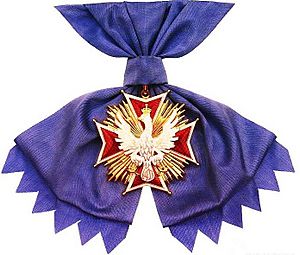 |
|
| Awarded by the President of Poland (previously King of Poland) |
|
| Type | Single grade order |
| Established | 1 November 1705 |
| Country | |
| Motto |
|
| Eligibility | All |
| Status | Currently awarded |
| Grand Master | President of Poland Karol Nawrocki |
| Statistics | |
| Total inductees | 355 (since 1921) |
| Precedence | |
| Next (higher) | none – highest award |
| Next (lower) | Order Virtuti Militari |
The ribbon bar of the Order |
|
The Order of the White Eagle (in Polish, Order Orła Białego) is Poland's highest and most important award. It is one of the oldest honors in the world that is still given out today.
The award was created on November 1, 1705, by King Augustus II the Strong. He gave it to eight of his most loyal friends and political allies. Since then, it has been awarded to the most outstanding Polish citizens for their great service to the country. It is also sometimes given to leaders of other nations.
People who receive the Order wear it on a blue sash that goes from their left shoulder to their right hip. They also wear a star-shaped badge on the left side of their chest. Unlike many other awards, the Order of the White Eagle has only one level, or class.
Contents
The History of the Order
The Order of the White Eagle has a long and interesting history that has changed along with Poland itself.
How It Started
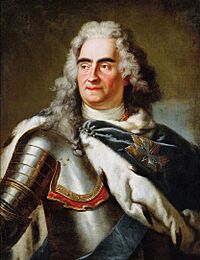
The very first badge for the Order was a gold medal with a red enamel coating. It showed a Polish white eagle on the front. The back had the king's initials over two crossed swords. It was worn on a light blue ribbon.
In 1713, the design was changed to a Maltese cross shape. It was worn around the neck with a blue sash and a star badge. King Augustus II may have been inspired by other famous European orders, like the French Order of the Holy Spirit.
At first, many Polish nobles did not like the new Order. They believed that all nobles were equal, and this award created a special class that was above others.
Changes Through the Centuries

When Poland was divided by its neighbors in 1795 (an event called the Third Partition of Poland), the Order was stopped. However, it was brought back in 1807 for the Duchy of Warsaw, a state created by Napoleon Bonaparte.
Later, after the November Uprising of 1830–31, the Russian Empire took control of the Order. They changed its design to look more like Russian awards. This version of the Order existed until the Russian Revolution of 1917.
The Order in Modern Poland
After Poland regained its independence, the Parliament made the Order of the White Eagle the country's highest honor on February 4, 1921. The design was changed back to a more traditional Polish style.
During the time of the Polish People's Republic after World War II, the communist government did not award the Order. However, the Polish Government in Exile (a government that operated from outside Poland) continued to use it.
When communism ended in Poland, the Order was officially brought back on October 26, 1992. The first person to receive the newly restored Order was Pope John Paul II. Today, the President of Poland is the Grand Master of the Order and has the right to award it.
What the Order Looks Like
The appearance of the Order's badges, known as insignia, has changed over time.
The Original 1713 Design
The first badge was a red Maltese cross with a white border. In the center was a white eagle with a crown. The star of the Order was an eight-pointed gold star with a cross in the middle. The cross had the motto "Pro Fide, Lege et Rege" (For Faith, Law, and the King).
For special occasions, the King of Poland could wear the cross on a grand collar. This collar was made of 24 links showing white eagles and images of the Virgin Mary.
The Modern Design (Since 1921)
Today's badge is a gold Maltese cross with red enamel and a white border. A crowned white eagle is placed in the center. It is worn on a plain light blue sash. This design is very similar to the original from 1713.
The back of the badge has a design similar to the star. The star is an eight-pointed silver star with a red cross on top. The arms of the cross have the new motto: "Za Ojczyznę i Naród" (For Fatherland and Nation). In the center is the monogram "RP" for Rzeczpospolita Polska (Republic of Poland).
Who Has Received the Order?
The Order is given to people who have performed extraordinary services for Poland. This includes Polish citizens and important international figures.
Famous Polish Recipients
Many great Poles have been honored with the Order. Here are a few examples:
- Pope John Paul II: The first person to receive the Order after it was restored in 1992.
- Lech Wałęsa: A leader of the Solidarity movement and former President of Poland.
- Władysław Anders: A Polish general during World War II.
- Irena Sendler: A hero who saved over 2,500 Jewish children from the Warsaw Ghetto during the Holocaust.
- Wisława Szymborska: A Nobel Prize-winning poet.
- Andrzej Wajda: A world-famous film director.
- Witold Pilecki: A soldier who volunteered to be imprisoned in the Auschwitz concentration camp to gather information. He was awarded the Order after his death.
Famous International Recipients
Leaders and important figures from other countries have also received the Order to honor their friendship with Poland.
- Elizabeth II: The late Queen of the United Kingdom.
- Ronald Reagan: A former President of the United States, honored for his role in ending the Cold War.
- Václav Havel: The first President of the Czech Republic and a key figure in the fall of communism in Eastern Europe.
- Jacques Chirac: A former President of France.
- Volodymyr Zelenskyy: The President of Ukraine, awarded for his leadership and for strengthening the relationship between Poland and Ukraine.
- Akihito: The former Emperor of Japan.
Images for kids
-
A special diamond star that belonged to King Augustus the Strong.
See also
 In Spanish: Orden del Águila Blanca (Polonia) para niños
In Spanish: Orden del Águila Blanca (Polonia) para niños
- Polish military eagle
- 2019 Dresden heist
- Orders, decorations, and medals of Poland
- Order of the Pahonia


